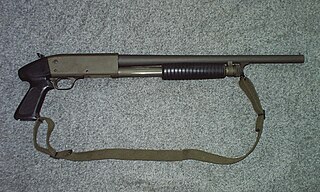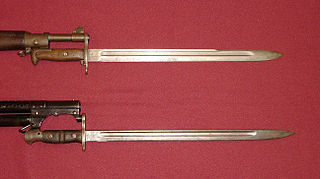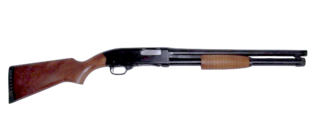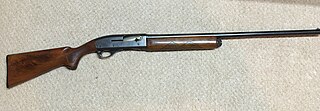
A shotgun is a long-barreled firearm designed to shoot a straight-walled cartridge known as a shotshell, which usually discharges numerous small pellet-like spherical sub-projectiles called shot, or sometimes a single solid projectile called a slug. Shotguns are most commonly smoothbore firearms, meaning that their gun barrels have no rifling on the inner wall, but rifled barrels for shooting slugs are also available.

The M1903 Springfield, officially the United States Rifle, Caliber .30-06, Model 1903, is an American five-round magazine-fed, bolt-action service repeating rifle, used primarily during the first half of the 20th century.
The Winchester Model 1897, also known as the Model 97, M97, or Trench Gun, is a pump-action shotgun with an external hammer and tube magazine manufactured by the Winchester Repeating Arms Company. The Model 1897 was an evolution of the Winchester Model 1893 designed by John Browning. From 1897 until 1957, over one million of these shotguns were produced. The Model 1897 was offered in numerous barrel lengths and grades, chambered in 12 and 16 gauge, and as a solid frame or takedown. The 16-gauge guns had a standard barrel length of 28 inches, while 12-gauge guns were furnished with 30-inch length barrels. Special length barrels could be ordered in lengths as short as 20 inches, and as long as 36 inches. Since the time the Model 1897 was first manufactured it has been used by American soldiers, police officers, and hunters.
Savage Arms is an American gunmaker based in Westfield, Massachusetts, with operations in Canada. Savage makes a variety of rimfire and centerfire rifles, as well as Stevens single-shot rifles and shotguns. The company is best known for the Model 99 lever-action rifle, no longer in production, and the .300 Savage. Savage was a subsidiary of Vista Outdoor until 2019 when it was spun off.

The Mossberg 500 (M500) is a series of pump action shotguns manufactured by O.F. Mossberg & Sons. The 500 series comprises widely varying models of hammerless repeaters, all of which share the same basic receiver and action, but differ in bore size, barrel length, choke options, magazine capacity, stock and forearm materials. Model numbers included in the 500 series are the 500, 505, 510, 535, and 590. The Revelation 310 and the New Haven 600 were also variations of the 500 series produced by Mossberg under different names. By 2021, 11,000,000 M500s had been produced, making it the most-produced shotgun of all time.
A combat shotgun is a shotgun issued by militaries for warfare. The earliest shotguns specifically designed for combat were the trench guns or trench shotguns issued in World War I. While limited in range, the multiple projectiles typically used in a shotgun shell provide increased hit probability unmatched by other small arms.
The Remington Model 870 is a pump-action shotgun manufactured by Remington Arms Company, LLC. It is widely used by the public for shooting sports, hunting and self-defense, as well as by law enforcement and military organizations worldwide.

The Ithaca 37 is a pump-action shotgun made in large numbers for the civilian, law enforcement and military markets. Based on a 1915 patent by firearms designer John Browning for a shotgun initially marketed as the Remington Model 17, it utilizes a novel combination ejection/loading port on the bottom of the gun which leaves the sides closed to the elements.
The Remington 1100 is a gas-operated semi-automatic shotgun introduced by Remington Arms in 1963.

The M1917 Enfield, the "American Enfield", formally named "United States Rifle, cal .30, Model of 1917" is an American modification and production of the .303-inch Pattern 1914 Enfield (P14) rifle, which was developed and manufactured during the period 1917–1918. Numerically, it was the main rifle used by the American Expeditionary Forces in Europe during World War I. The Danish Sirius Dog Sled Patrol on Greenland still use the M1917, which performs reliably in Arctic conditions, as their service weapon.

The M1917 bayonet was designed to be used with the US M1917 Enfield .30 caliber rifle, as well as with the seven different U.S. trench shotguns. The blade was 17 inches (43 cm) long. It will not fit the M1903 .30 caliber (Springfield) or the M1 .30 caliber (Garand) US service rifles as they have different bayonet ring (barrel) and attachment stud dimensions.
The Winchester Model 1912 is an internal-hammer pump-action shotgun with an external tube magazine. Popularly named the Perfect Repeater at its introduction, it largely set the standard for pump-action shotguns over its 51-year high-rate production life. From August 1912 until first discontinued by Winchester in May 1964, nearly two million Model 12 shotguns were produced in various grades and barrel lengths. Initially chambered for 20 gauge only, the 12 and 16 gauge versions came out in 1913, and the 28 gauge version came out in 1934. A .410 version was never produced; instead, a scaled-down version of the Model 12 known as the Model 42, directly derived from scaled drawings of the Model 12, was produced in .410.

The Model 1200 is a pump-action shotgun that was manufactured by the Winchester-Western Division of Olin Corporation, starting 1964. It was redesignated the Model 1300 in 1978 with minimal changes. Production ceased in 2006 when the U.S. Repeating Arms Company, the subsequent manufacturer, went bankrupt. A militarized version of the Model 1200 was acquired by the U.S. Army for use during the Vietnam War. It has seen service with the U.S. military in various conflicts through into the twenty-first century.

The Remington Model 11-48 is a semi-automatic shotgun manufactured by Remington Arms as the first of its "new generation" semi-automatics produced after World War II. Released as the replacement for the Remington Model 11, it was manufactured from 1949 to 1968 and was produced in 12, 16, 20 and 28 gauge and .410 variations.
The Remington Model 31 is a pump-action shotgun that competed with the Winchester Model 1912 for the American sporting arms market. Produced from 1931 to 1949, it superseded the John Pedersen-designed Models 10 and 29, and the John Browning-designed Model 17. It was replaced by the less expensive to manufacture Model 870 in 1950.
The Remington Model 30 is a US sporting rifle of the inter-war period based on the military P14/M1917 Enfield rifle action, which was manufactured for the British and US governments during World War I. Initial specimens used surplus military parts with some modifications in order to consume the stock of parts, though further modifications were made as production progressed and later rifles were produced from newly manufactured parts. Most early rifles were in the military .30-06 calibre used in the M1917 but it became available in a variety of chamberings. It was the first high-powered bolt-action sporting rifle produced by Remington. Some would beg to differ as Remington made the Remington Lee factory sporting rifle from 1899-1909, 1446 were built in a variety of calibers.
The Remington Model 887 Nitro Mag is a pump-action shotgun manufactured by Remington Arms Company, Inc. It is noted for using a polymer finish called ArmorLokt, which is designed to survive any type of weather condition and leaves no exterior surfaces to rust. This gives the 887 a "space age" look which is one of the gun's more defining features.
The Stevens Model 77E was a pump-action shotgun offered in 12 gauge, 16 gauge, 20 gauge, 28 gauge, and 410 gauge. The military version 77E was the most widely used shotgun of the Vietnam War. It was a short-barreled pump-action shotgun known variously as the "trench" or "riot" shotgun in 12 gauge. The Military Model 77E had a noticeably shorter stocks than similar United States military shotguns built by Ithaca Gun Company, Remington Arms, and Winchester Repeating Arms Company. These short stocks were intended to accommodate South Vietnamese soldiers, and the Military Model 77E was the first United States combat shotgun equipped with a rubber recoil pad. Military Model 77E shotguns were Parkerized with sling swivels and wooden stocks. Receivers were marked "U.S." and "p" proofmarks appeared on both barrels and receivers.
The Stevens Model 520 was a pump-action shotgun developed by John Browning and originally manufactured by the J Stevens Arms & Tool Company between 1909 and 1916. Stevens was sold to New England Westinghouse on 28 May 1915 and production of civilian firearms was greatly reduced. The company was renamed the "J Stevens Arms Company" on 1 July 1916 and New England Westinghouse used their manufacturing facility in Chicopee Falls, MA to produce Mosin-Nagant rifles under contract for the Russian Czar during World War I. After the war, Stevens was sold to Savage Arms on 1 April 1920 and full production of civilian firearms resumed. Under Savage ownership, Model 520 production continued until 1939 when it was replaced by the Model 520A which ended production in 1948. Stevens also further modified the design when they introduced the streamlined Model 620 in 1927. The Model 620 was internally similar to the Model 520 and was produced until 1939 when it was replaced by the Model 620A which ended production in 1955. This shotgun is a hammerless, pump action, take-down design with a tubular magazine which holds 5 shells. All models can also be slam fired: the shotgun has no trigger disconnector and shells can be fired one after the other simply by working the slide if the trigger is held down.








